History
Prior to adopting Glenferrie Oval as the club's traditional home, the Hawthorn Football Club had a nomadic history, playing home games at whatever the most suitable obtainable ground was for that season. Their first home ground was the Hawthorn C.G. (West Hawthorn Reserve), which was abandoned after just 1 season due to conditions imposed by the Hawthorn Cricket Club, with the Hawks playing at John Wren's Richmond Racecourse in 1903 (which was off Bridge Road between Stawell Street and Westbank Terrace – where Tudor Street with 5 no through streets branches of are now located), before moving to the Richmond Cricket Ground in 1904. [4]
The Hawks' merger with Boroondara in 1905 had them move to Boroondara's ground, which at the time was the East Melbourne Cricket Ground. Hawthorn dropped their colours of blue and red (similar to Melbourne's guernsey at the time) and adopted Boroondara's colours, which was a black guernsey with red sash but retained the name Hawthorn FC. When the Hawthorn council opened Glenferrie Oval, then known as the Hawthorn City Sports Ground in October 1905, they endeavored to get a senior club to represent the district to be the main tenant during the next football season. The Hawthorn FC, competing in the Metropolitan Junior Football Association (now known as the VAFA), and Hawthorn Rovers (a popular club in the Eastern Suburbs Association) merged to form the Hawthorn City Football Club and made Glenferrie their home ground (the word City was later dropped and the club was just known as the Hawthorn Football Club when it entered the VFA in 1914) . [5]
Between 1906 and 1973, the Hawks played their home games at Glenferrie Oval, which was located in the heart of the affluent suburb of Hawthorn. The state of Glenferrie Oval and its location, close by the Glenferrie train station on the Melbourne East route, was a central reason why the club was firstly accepted into the VFA in 1914, and then the VFL in 1925. The club's onfield results had not reached any great heights in those early days but both the VFA and VFL had recognised the importance for representation in the suburbs east of the Yarra River. Glenferrie Oval was pivotal in these advancements of the Hawthorn Football Club as it was considered the most suitable at the time. [6]
In 1914, when Hawthorn entered the VFA, the council was required to build a new dressing shed to meet the standards of the VFA competition. These dressing sheds were erected in the north-west corner of the ground, where the Tuck Stand now resides, and were later moved to the Rathmines Road Reserve in Hawthorn where it still exists today. In 1922 the ground was widened by 30 yards and lengthened westward by 50 yards - taking in the previous outer reserve ground - to the dimensions that remain today. [7]
The 1922 ground improvements also resulted in Glenferrie Oval's first main stand, which was a wooden structure to be known as the Kennon-Owen Stand, and had been purchased from the East Melbourne Cricket Ground in late 1921 when that ground was closed due to expansion of the Jolimont railyards. The Kennon-Owen Stand was replaced by the Dr A S Ferguson Stand, a new brick stand opened in 1966 which was 185 feet long and could seat 1450, with 400 undercover. It was later to be home of the Past Players Association and the original Museum. The northern part of the Ferguson stand was demolished to make way for the Victorian Weightlifting Building that remain today. [8]
Glenferrie Oval's grandstand, designed in an art-deco style, was built in 1937 and later named the Michael Tuck stand after the club great, and housed the new changerooms and administration of the club. It is now heritage protected as one of the most significant buildings of the era. In 1963 the large scoreboard was erected at the eastern end of the ground. After the club won the 1961 premiership it was decided to buy some houses on the other side of Linda Crescent to build the Social Club which opened in 1962. The ground was relatively small by VFL standards, but the intimate nature of the ground (with the grandstands and train line surrounding the ground) made for a terrific atmosphere. The Hawks had played 584 matches at Glenferrie Oval during their time there. The last game that Hawthorn played at Glenferrie Oval was in August 1973 when Hawthorn won against South Melbourne by 37 points, in front of a crowd of 9842 people. [9]
Hawthorn Football Club retained the ground as an administrative and training base until 2006. Hawthorn moved their administrative and training facilities to a redeveloped Waverley Park early in 2006 in preparation for the 2006 AFL season. [10] [11]
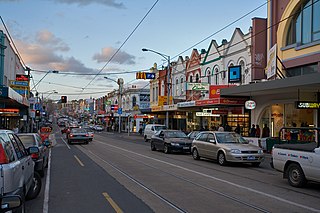
Hawthorn is an inner suburb of Melbourne, Victoria, Australia, 6 kilometres (3.7 mi) east of Melbourne's central business district, located within the City of Boroondara local government area. Hawthorn recorded a population of 22,322 at the 2021 census.
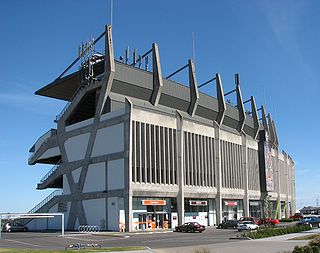
Waverley Park was an Australian rules football stadium in Mulgrave, Victoria, Australia. For most of its history, its purpose was as a neutral venue and used by all Victorian-based Victorian Football League/Australian Football League clubs. During the 1990s it became the home ground of both the Hawthorn and St Kilda football clubs.

Windy Hill is an Australian rules football and cricket ground located in Napier Street, Essendon, a northwestern suburb of the Melbourne metropolitan area.

Victoria Park is a sports venue in Abbotsford, a suburb of Melbourne in Victoria, Australia. The stadium is oval shaped and was built to host Australian rules football and cricket matches. In the past Victoria Park featured a cycling track, tennis courts, and a baseball club that once played curtain raisers to football matches.

Junction Oval is a historic sports ground in the suburb of St Kilda in Melbourne, Victoria, Australia.
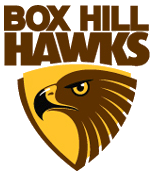
The Box Hill Hawks Football Club is an Australian rules football club playing in the Victorian Football League (VFL). It has a reserves affiliation with the Hawthorn Football Club, which plays in the Australian Football League (AFL).

Arden Street Oval is a sports oval in North Melbourne, Victoria, Australia. It is currently the training base of the North Melbourne Football Club, an Australian rules football club, and up to the end of the 1985 season it was used as the team's home ground for Victorian Football League (VFL) matches.
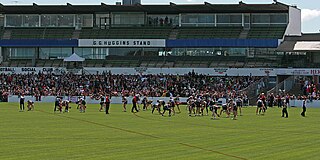
Moorabbin Oval is an Australian rules football ground in the city of Melbourne, Victoria, Australia at Linton Street in the suburb of Moorabbin.
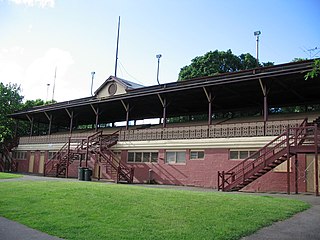
The WT Peterson Community Oval, best known as the Brunswick Street Oval and also as the Fitzroy Cricket Ground, is an Australian rules football and cricket ground located in Edinburgh Gardens in Fitzroy North, Victoria, Australia.

The East Melbourne Cricket Ground was a grass oval sports venue located at the corner of Wellington Parade and Jolimont Parade, in East Melbourne, Victoria, Australia. Now part of Yarra Park and being adjacent to the Melbourne Cricket Ground, the site is best known for playing host to many sporting events during the city of Melbourne's early existence, consisting mainly of cricket and Australian rules football, although the ground occasionally hosted soccer matches.

Punt Road Oval, also known by naming rights sponsorship as the Swinburne Centre, is an Australian rules football ground and former cricket oval located within the Yarra Park precinct of East Melbourne, Victoria, situated a few hundred metres to the east of the Melbourne Cricket Ground (MCG).

Coburg City Oval is an Australian rules football and cricket stadium located in Coburg, Australia. It is home to the Coburg Football Club in the Victorian Football League, and the Coburg Cricket Club.

Australian rules football in Victoria is the most watched and second most participated code of football. Australian rules football originated in Melbourne in the late 1850s and grew quickly to dominate the sport, which it continues to. Victoria has more than double the number of players of any other state in Australia accounting for approximately 42% of all Australian players in 2023 and continues to grow strongly. Only Soccer in Victoria has more football participants, though the code's growth in Victoria has made up much ground lost to that code over previous decades such that they have now a similar number of players. The sport is governed by AFL Victoria based in Melbourne. The national governing body, the AFL Commission is also based in Melbourne.
Princes Park is an Australian rules football ground located inside the Princes Park precinct in the inner Melbourne suburb of Carlton North. Officially the Carlton Recreation Ground, it is a historic venue, having been Carlton Football Club's VFL/AFL home ground from 1897.
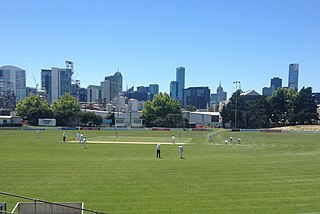
North Port Oval, also known as the Port Melbourne Cricket Ground or by the sponsored name ETU Stadium, is an Australian rules football and cricket stadium located in Port Melbourne, Australia. The capacity of the venue is 6,000 people. It is home to both the Port Melbourne Cricket Club and the Port Melbourne Football Club.
The 1956 VFL season was the 60th season of the Victorian Football League (VFL), the highest level senior Australian rules football competition in Victoria. The season featured twelve clubs, ran from 14 April until 15 September, and comprised an 18-game home-and-away season followed by a finals series featuring the top four clubs.

The Hawthorn Football Club, nicknamed the Hawks, is a professional Australian rules football club based in Mulgrave, Victoria, that competes in the Australian Football League (AFL). The club was founded in 1902 in the inner-east suburb of Hawthorn, making it the youngest Victorian-based team in the AFL.

Box Hill City Oval is an Australian rules football and cricket stadium located in Box Hill, Victoria, Australia. It is the home ground of the Box Hill Hawks Football Club which plays in the Victorian Football League, and the Box Hill Cricket Club which plays in the Victorian Sub-District Cricket Association.
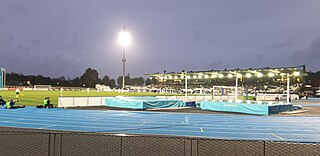
Lakeside Stadium is an Australian sports arena in the South Melbourne suburb of Albert Park. Comprising an athletics track and soccer stadium, it currently serves as the home ground and administrative base for association football club South Melbourne FC, Athletics Victoria, Athletics Australia, Victorian Institute of Sport and Australian Little Athletics.

Central Reserve is a cricket and Australian rules football ground in the suburb of Glen Waverley, in the south-east of Melbourne, Victoria, Australia. It is located at the intersection between Waverley Rd and Springvale Rd. It is the current home of the Richmond Cricket Club in the Victorian Premier Cricket competition and it is also the current home of Mazenod Old Collegians Football Club, who currently play in the VAFA, in Premier B. And Glen Waverley Hawks Football Club currently playing in the EFL Division 4.



















